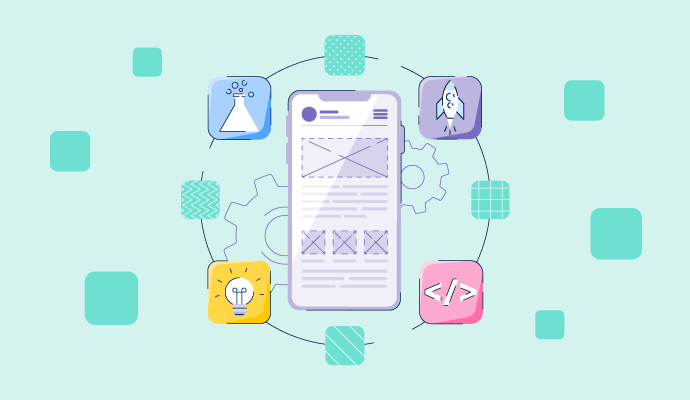
Developing an app is hard.
There’s no reason to sugarcoat it. The app development process can be long, frustrating, and daunting. Thankfully, it doesn’t have to be. Let’s go through the mobile development lifecycle, what you should expect, and some tools that could help you along the way.
Below is your typical mobile development lifecycle:
The first step to building a mobile app is understanding why you are building a mobile app. Start by asking these questions:
By no means is this list exhaustive, but these questions can help guide the planning process for your app. Don’t build the app just for the sake of having an app, because it’s far better to have not built at all than to build something subpar that your target audience won’t enjoy. Build with intent. Build an app that your audience will want to use. To make that happen, planning is absolutely necessary.
Your business’ marketing team should also build a campaign around the new app prior to deployment to improve visibility and hype before and during launch. Campaign building should start in the planning phase, but it needs to be flexible to app capability fluctuations until the product’s core functions are confirmed.
Once you’ve got the app planned, you can get into design. During the app design phase, you and your business should be focusing on two aspects: functionality and the user interface (UI). While the UI covers what users see in the app and what they interact with, the functionality aspect focuses on how the app actually works and what users can do with it.
For developing the user experience, a common practice is wireframing. In simplest terms, wireframing is a rough draft of what users see. It’s a quick-and-dirty approach to arranging the app in a way that makes sense for the end user. What’s nice about using wireframing tools in particular during the design stage is that wireframe tools are incredibly flexible. Think of wireframing almost like a wall full of sticky notes: You’ve got the freedom to add, move, and remove ideas according to what might work best for the end user.
The development side of design tends to be more consulting-oriented, but one or more members of the dev team should always be involved in the design stage. They need to give input about what your business should realistically expect from the app’s functions.
The development stage is composed of two distinct parts: the first, prototyping, is meant to be quick, whereas the second, building, is the actual production of the end product.
While this might feel like overkill, or perhaps like it would slow down the development process, app prototyping can be an invaluable part of the development process. Prototypes are quick builds — in this case, of the mobile application — that are used to test design ideas before moving forward with the actual build process. Prototypes are the translation of the initial idea into a practical model of how that idea operates.
The limitation of wireframing and preliminary UI design is that you can’t see how the app draft behaves in practice. Prototyping the design allows the app developer or development team the opportunity to test their initial ideas and see what might be missing or problematic before formally moving into the building stage. Foresight like this can help prevent extended delays and numerous mid-build changes that would drastically slow the build process and prevent expedient application release.
Now that you’ve knocked out the initial kinks with the app prototype, you can start the build process. The actual app build is where your developer(s) should be pouring in the most time. In this stage, the initial plans, designs, and lessons learned from prototyping all come together as a guidebook for creating the end product.
Build tools can directly target the level of experience your developer(s) have. For individuals or small businesses that might not have extensive development experience, no-code development platforms or low-code development platforms may be the perfect option for building the app. For enterprises, mobile development platforms give experienced developers the most extensive array of features and options to build with, potentially sacrificing a certain level of expediency for thoroughness and greater app capability.
You should also expect the greatest fluidity of the entire mobile app development lifecycle during the build stage. Getting deep into the app build can expose hidden issues with the expected functions for the app, and also result in new ideas that might not have come up during planning and prototyping. Keep in mind that you don’t want to get stuck in an idea development loop here though. If the idea is too broad, or maybe just not entirely cohesive with the current build, the idea may be better to hold onto as a feature update sometime after launch. 
In this stage, your developers want to make sure that everything in the app actually works. Mobile app testing goes through every single action in the app — from the most used to the least — to verify that nothing “breaks.” This testing can be done either by software solutions, dedicated QA analysts, or crowdsourced testing solutions.
A break could be:
A break could also take the form of a variety of other potential failures that make an app feel incomplete or half-baked. Every company should be aiming to minimize the number of errors or breaks as much as possible before app launch. An app that isn’t adequately tested prior to launch risks failure right out of the gate. Early app reviews are incredibly important due to the low sample size, and enough mediocre or poor ratings can doom an app before it ever really gets off the ground.
All right, the app has been conceptualized, prototyped, built, and tested. Now you’re finally ready to launch the application.
Prior to this point, other parts of your business should have determined the pricing structure for your app, or how the app might otherwise be monetized. Some of the more common revenue-driving options include:
Broad-scale deployment will usually involve an intermediary called an app marketplace or app store. The intermediary hosts the app for users to purchase and/or download in exchange for a hosting fee and, sometimes, a percentage of the sale price. Keep in mind the costs to launch and maintain an app in an app marketplace: The host usually charges a publishing cost, a transaction fee for each download, or both.
Graphic via G2’s Bridget Poetker, discussing how much it costs to make an app.
This step is the “lifecycle” part of the “mobile development lifecycle” that people tend to forget about. What turns mobile development into a lifecycle is constantly maintaining the application beyond its initial release.
What if users find an unexpected issue with the app’s performance on a certain device? What if you think of a new feature that might be great for your app? Or, arguably most importantly, how do you maintain your app’s relevance and functionality as mobile device hardware and software evolves?
All of these questions should be key considerations before you ever develop your app, and if they weren’t, they absolutely should be upon deployment. Otherwise, you’ve built your app for a snapshot in time, and you risk your app falling into irrelevance. The maintenance step should be a constant, proactive way of ensuring your app’s health and usability for as long as the app is needed.
Need to figure out the type of app that would be best for your business? Learn here about web apps and mobile apps – one might be better for your business than the other!
Zack is a former G2 senior research analyst for IT and development software. He leveraged years of national and international vendor relations experience, working with software vendors of all markets and regions to improve product and market representation on G2, as well as built better cross-company relationships. Using authenticated review data, he analyzed product and competitor data to find trends in buyer/user preferences around software implementation, support, and functionality. This data enabled thought leadership initiatives around topics such as cloud infrastructure, monitoring, backup, and ITSM.
Whether you’re new to programming or have years of experience, there’s always something more...
 by Bridget Poetker
by Bridget Poetker
Believe it or not, coming up with your app idea was the easy part.
 by Bridget Poetker
by Bridget Poetker
Turn your passion projects into a full-time job.
 by Bridget Poetker
by Bridget Poetker
Whether you’re new to programming or have years of experience, there’s always something more...
 by Bridget Poetker
by Bridget Poetker
Believe it or not, coming up with your app idea was the easy part.
 by Bridget Poetker
by Bridget Poetker


